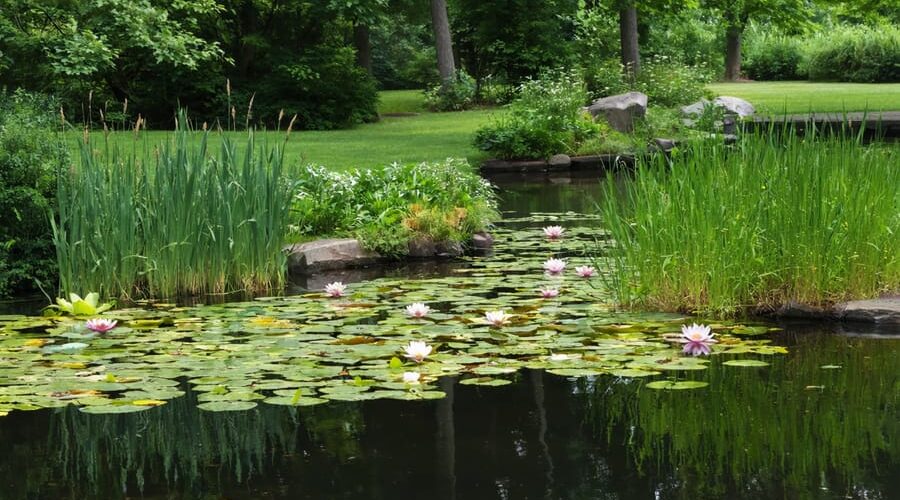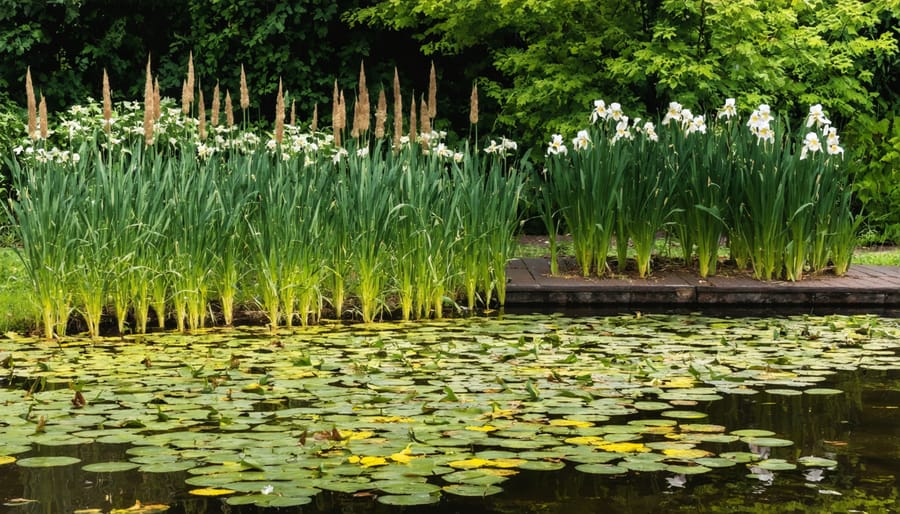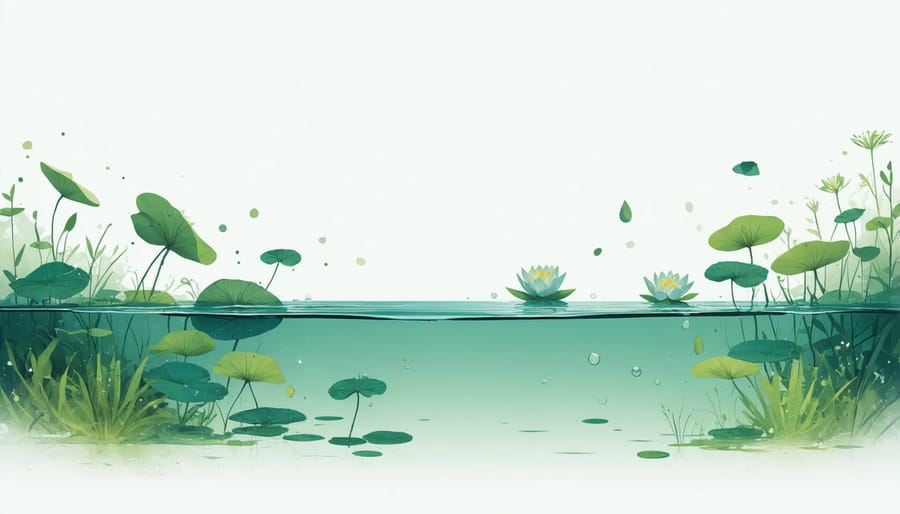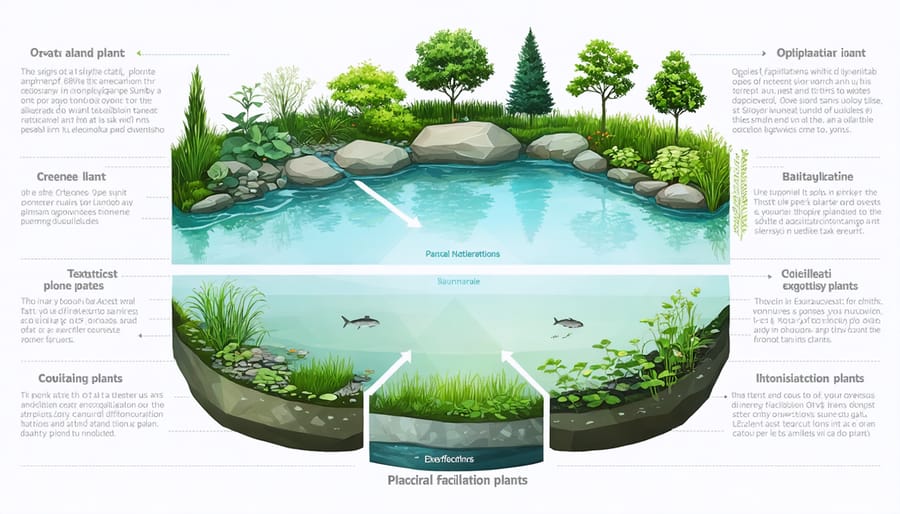
How Facilitation Plants Create Natural Harmony in Your Water Garden
Transform your water garden into a thriving ecosystem with facilitation plants – nature’s master gardeners that nurture and support surrounding aquatic life. These remarkable plants create beneficial relationships in your pond, improving water quality and enhancing the overall health of your aquatic environment. Like skilled architects of the underwater world, facilitation plants provide shelter for fish, reduce algae growth, and establish essential nutrient cycles that benefit every organism in your water garden.
From the sturdy cattails that protect smaller plants from wind and waves to the floating water lilies that shade fish and regulate water temperature, facilitation plants work tirelessly to create perfect conditions for their neighbors. Whether you’re establishing a new pond or enhancing an existing water feature, understanding these plant relationships helps you create a more resilient and self-sustaining aquatic landscape.
Let’s explore how these botanical helpers can revolutionize your water garden, making it more beautiful, balanced, and easier to maintain.
What Makes a Plant a Natural Facilitator?
Protective Pioneers
Facilitation plants are nature’s nurturing heroes, creating safe spaces where other plants can thrive. Think of them as protective umbrellas in your water garden, shielding smaller or more delicate species from harsh conditions. These pioneer plants break down tough soil, provide shade, and create windbreaks that help their neighbors flourish.
In water gardens, taller marginal plants like cattails and rushes act as natural barriers, protecting smaller floating plants from strong winds and waves. They also help maintain stable water temperatures by providing shade, which is especially important for sensitive aquatic species.
Below the surface, these helpful plants improve water quality by absorbing excess nutrients and releasing beneficial compounds that can deter algae growth. Their roots create complex underwater networks that provide shelter for fish and beneficial microorganisms while stabilizing soil and preventing erosion.
Some facilitation plants even release chemicals that enhance the growth of neighboring plants, creating a nurturing environment where your entire water garden ecosystem can thrive.

Natural Support Systems
Facilitator plants don’t work alone in your water garden – they’re part of a fascinating web of natural relationships. These helpful plants work alongside beneficial insects, providing shelter and breeding grounds for natural pest controllers like ladybugs and praying mantises. They also create perfect hiding spots for small fish, which help control mosquito larvae and other unwanted insects.
The root systems of these plants form natural filters, working with beneficial bacteria to keep water clean and clear. Many facilitator plants also partner with fungi in the soil, creating underground networks that share nutrients and support younger plants. Some even release natural compounds that discourage algae growth while promoting the health of nearby aquatic plants.
In my years of water gardening, I’ve noticed how these plants create mini-ecosystems. When you add facilitator plants, you’re not just adding one element – you’re inviting a whole community of helpful garden allies to make your water feature thrive naturally.
Top Facilitation Plants for Your Water Garden
Marginal Facilitators
The transition between water and land creates a unique opportunity for natural plant integration that enhances your pond’s ecosystem. These marginal facilitators thrive in the shallow edges, where they can have their roots in water while their foliage remains above the surface.
Popular choices include iris, which adds dramatic vertical interest with its sword-like leaves and stunning blooms. Rush plants, like the common rush or zebra rush, create wonderful textural elements while helping to stabilize the pond’s edge. For color throughout the growing season, consider marsh marigolds with their cheerful yellow flowers in spring, followed by the purple spikes of pickerelweed in summer.
These edge-dwelling plants serve multiple purposes: they help prevent soil erosion, provide shelter for wildlife, and create natural filtration for your pond water. When planting, use sturdy containers with plenty of drainage holes and heavy clay-based soil to keep plants anchored. Position them on shelves or stack bricks to achieve the ideal water depth – usually between 1-6 inches depending on the species.
Remember to trim back dead foliage regularly and divide overcrowded plants every few years to maintain their health and appearance. With proper placement and care, these marginal facilitators create a seamless transition between your pond and surrounding landscape.
Submerged Helpers
Beneath the surface of your pond, submerged plants work tirelessly as nature’s underwater helpers, playing a crucial role in maintaining a healthy aquatic ecosystem. These unsung heroes contribute significantly to water garden filtration by absorbing excess nutrients and providing oxygen to the water.
Popular submerged helpers include Hornwort, which acts like a natural filter by trapping debris and providing shelter for beneficial microorganisms. Anacharis, another fantastic option, releases generous amounts of oxygen during daylight hours, helping maintain optimal water conditions for fish and other aquatic life.
These plants also compete with algae for nutrients, naturally helping to keep those pesky green blooms under control. Think of them as your pond’s cleanup crew! Water Milfoil and Fanwort are excellent choices for beginners, as they’re hardy and adaptable to various water conditions.
For best results, plant these helpers in small bunches, anchoring them to the bottom of your pond with weights or by planting them in submerged containers. A good rule of thumb is to cover about 50-60% of your pond’s bottom with these beneficial plants. Remember to trim them occasionally to prevent overcrowding and maintain healthy growth.
Not only do these underwater plants help maintain water quality, but they also provide valuable hiding spots for fish fry and aquatic insects, creating a thriving mini-ecosystem in your backyard oasis.

Strategic Plant Placement

Creating Plant Communities
Creating successful plant communities in your water garden is like arranging a perfect dinner party – everyone needs to get along and support each other! Start by selecting plants that naturally complement one another. For example, pair tall marginal plants with shorter floating varieties to create layers of interest and protection.
Think in terms of groups of three or more plants. A classic combination might include a tall reed or rush providing shelter, a mid-height flowering plant offering color, and a lower-growing ground cover spreading beneath. This creates a natural-looking arrangement while maximizing the benefits of plant facilitation.
Consider the specific needs of each plant when grouping them. Some plants work particularly well together – like water lilies providing shade for fish while receiving nutrients from fish waste in return. Remember to space your plants appropriately, giving them room to grow while maintaining their supportive relationships.
Don’t forget about seasonal changes when planning your plant communities. Include a mix of early, mid, and late-season plants to ensure your water garden maintains its supportive structure throughout the growing season.
Seasonal Considerations
Spring is the ideal time to introduce facilitation plants to your water garden, as they’ll have plenty of time to establish themselves before the peak growing season. When maintaining your water garden, pay special attention to these plants during seasonal transitions. In early spring, trim back any dead foliage and divide overgrown plants to encourage healthy growth.
During summer, monitor water levels more frequently, as facilitation plants can increase evaporation rates. Fall is the perfect time to thin out excessive growth and remove fallen leaves before they decompose in the water. In winter, avoid cutting back marginal plants completely – their stems provide valuable shelter for wildlife and help maintain water quality.
For tropical facilitation plants, consider moving them to protected areas or indoor containers during cold months. Remember that different species have varying cold tolerances, so research your specific plants’ needs. Keep an eye on water chemistry throughout the year, as seasonal changes can affect how these plants interact with their environment.
Common Mistakes to Avoid
When working with facilitation plants, even experienced gardeners can make mistakes that hinder their success. One common error is overcrowding your plants, which can lead to competition for nutrients and reduced effectiveness of the facilitation process. Remember to give each plant enough space to grow and establish properly.
Another frequent mistake is choosing incompatible plant combinations. Not all plants work well together, and some may actually inhibit rather than help each other. Research your plant pairs carefully before placing them together in your water garden.
Timing is crucial, and many gardeners introduce facilitation plants too late in the season. For best results, establish these helpful plants early in the growing cycle so they can support other species as they develop.
Neglecting soil preparation is another pitfall to avoid. Even though facilitation plants are generally hardy, they still need proper growing conditions to thrive and support other plants effectively.
Some gardeners also make the mistake of removing facilitation plants too early, thinking their job is done once the target plants are established. However, these helpful plants often provide ongoing benefits and should be maintained as part of your garden’s ecosystem.
Lastly, don’t forget about maintenance. While facilitation plants are typically low-maintenance, they still need basic care like pruning and monitoring for disease. Regular attention ensures they continue to benefit your water garden effectively.
Incorporating facilitation plants into your water garden is more than just adding beauty – it’s creating a thriving ecosystem that benefits every living thing in and around your pond. These helpful plants work tirelessly to support other species, improve water quality, and create natural balance in your aquatic environment. By choosing the right combination of facilitation plants, you’ll reduce maintenance work while enhancing the health and visual appeal of your water garden. Whether you’re a beginner or experienced water gardener, implementing these plants is a rewarding step toward creating a more sustainable and vibrant pond ecosystem. Start small with a few key species, observe their positive impact, and gradually expand your collection. Your water garden will thank you with clearer water, happier fish, and a more beautiful outdoor space that you can enjoy for years to come.
